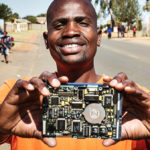 This post was written by guest blogger Pauline Vogl, Project Manager, Sustainable Business Practices at Cisco.
This post was written by guest blogger Pauline Vogl, Project Manager, Sustainable Business Practices at Cisco.
I’m a champion for environmental sustainability. As a member of Cisco’s Corporate Affairs team, I’m constantly looking for ways to be a global problem solver and positively impact people, society, and especially the planet. From employee initiatives like reducing paper cup usage to cross-functional teams like Make IT Green to this month’s Earth Aware activities, there are plenty of opportunities for employees to become champions for the planet.
And off campus, there’s a world of possibility, one I discovered when I began volunteering through Citizen Schools four years ago. The nonprofit organization provides daily science, technology, engineering, and math (STEM) education to underserved middle schoolers in the United States through its Extended Learning Time (ELT) model.
“Citizen Teachers” such as myself lead 10-week, after-school courses on the topics they believe are critical, but aren’t being taught in the classroom; every fall, a few environmentally conscious colleagues and I teach sixth, seventh, and eighth graders about their carbon footprints and how they can reduce them at school and at home.

Many of the students we teach come from low-income families in East San Jose, where high-school graduation rates are just 59%. Those who participate in after-school courses graduate at a much higher rate (71%) and are 25% more likely to enroll in college than their national peers. For me, it’s not only important that these students graduate with the skills they’ll need to succeed in college and beyond, but that they realize the immediate and communal benefits of practicing environmental sustainability.
Our Carbon Footprint course is broken down into four sections: Water, Carbon Emissions, Waste, and Electricity. These are all topics we might understand, but bringing them down to a middle schooler’s level can be challenging. One of my favorite exercises is showing the students side-by-side pictures of Lake Oroville in Northern California from 2010 and 2014. The cartoon-like widening of their eyes when they see the difference tells me they understand the impact of droughts; it’s unlocking this knowledge that brings me the most joy.
One year, a student raised her hand after seeing the images and shared her own example of water conservation. “My grandma saves water from the kitchen and pours it into plants,” she said. If we can teach children that turning off a light, taking shorter showers, or lowering the thermostat in the winter makes a difference, we’re preparing them to be more sustainable later in life.

Sometimes, all it takes is a field trip to Cisco’s cardboard crusher, a tour of Repo Depot—our Cisco equipment reuse facility—or a hands-on activity transforming household waste into instruments to “turn on” their lightbulbs. My students are the future; they’re the ones inheriting this planet, and I believe it’s important they learn early on that their actions can make a difference in the world.
If I’ve learned anything in my seven years at Cisco, it’s that you can turn something that’s part of your daily job into something you’re passionate about. For me, that’s sustainability.
This April and May, Cisco will host activities, events, and volunteer opportunities across Cisco offices to encourage employees to engage in environmentally responsible behaviors at work and at home. Last year, hundreds of employees around the world volunteered, and more than 425 volunteered from Cisco’s San Jose campus.
They helped local charities and organizations harvest sustainable produce, maintained the San Jose Heritage Rose Garden, learned how to host a Bike to Work Day, recycled electronic waste, picked up litter around Cisco, and planted trees.
Employees this year can:
- Sign up online to volunteer for over 30 global activities
- Donate to a number of Cisco Foundation-approved organizations
- Join our internal sustainability community, Cisco Greenhouse
- Attend SustainX on May 16th, where you’ll learn how employees turned their passion into business value at Cisco
Whether we’re volunteering through Citizen Schools or finding ways to be more “green” with our fellow employees, we can all be champions for environmental sustainability.
Stay informed about how Cisco is accelerating global problem solving for people, society, and the planet. Sign up for our email list today.


Great post! Link to Repo Depot is not working.
Fantastic program Pauline!